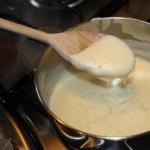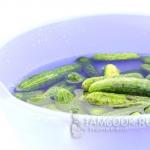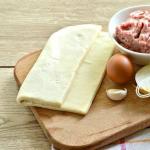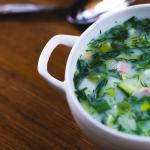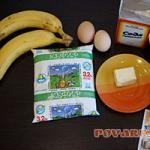Okroshka with kefir. A selection of the best recipes for okroshka with sausage How to store okroshka in nature
If in Russia okroshka has long been made with kvass, then in some other countries, for example, in Turkmenistan, this dish has always been seasoned with kefir. Kefir itself is a dietary drink - it improves metabolism and helps a lot in getting rid of extra pounds. Being the basis of okroshka, kefir makes this dish dietary. The secret is that okroshka made with kefir turns out softer than with kvass. Okroshka with kefir has a low calorie content and a fairly low fat content - approximately 0.3 g of fat per 100 g of dish.
Now let's look at a few recipes to learn how to make okroshka with kefir.
You will need:
– veal – 150 g
– eggs – 5 pcs.
– radishes – 1 bunch
– fresh cucumbers – 4 pcs.
– fresh beets – 1 pc.
– potatoes – 3-4 pcs.
- dill, green onions, parsley - to taste
— 1.5% kefir – 1.5 l
- salt, pepper - to taste
Preparation
Wash the potatoes, peel and boil. Hard boil the eggs. Wash and boil the veal. Wash the radishes, cucumbers and beets, peel the beets, finely chop or grate all the vegetables. Do the same with boiled eggs. Cut the boiled veal into cubes. Wash the greens and chop finely.
Then mix radishes, cucumbers, beets, eggs, veal and herbs, add salt and pour kefir. Let the okroshka brew for a while.
As you have already noticed, we did not add boiled potatoes to the okroshka; it must be served as an addition to this dish.
You will need:
– beef sausages – 140 g
– fresh tomato – 1 pc.
– fresh cucumbers – 2 pcs.
– fresh red bell pepper – 1 pc.
- green onions - to taste
– 2% kefir – 1 l
Preparation
Boil the sausages, cut into cubes. Wash vegetables and herbs. Cut the tomato and cucumbers into cubes, peel the peppers and cut them in the same way, finely chop the green onions.
Mix all the ingredients thoroughly and pour in cold kefir, let the okroshka brew for a while before serving.
You will need
:
– doctor’s sausage – 250 g
– fresh cucumbers – 4 pcs.
– radishes – 6 pcs.
– potatoes – 4 pcs.
– eggs – 4 pcs.
– sweet red pepper – 1 pc.
- green onions, dill, parsley, sour cream, salt, pepper - to taste
— 1% kefir and mineral water
Preparation
Boil the potatoes until tender, hard-boil the eggs, cool the potatoes and eggs and cut into cubes.
Wash cucumbers, radishes and peppers, remove seeds from peppers. Cut the sausage, cucumbers, radishes and peppers into cubes.
Mix all ingredients thoroughly, add kefir and mineral water in a ratio of 1:1.5. Do this by eye, so that the okroshka is not too thick, but not too runny. After this, add sour cream, salt, pepper and herbs to taste, mix thoroughly again.
Place the finished okroshka in the refrigerator for 30-40 minutes and only then serve.
Helpful advice: if you want the okroshka to last longer, do not add kefir and mineral water to the ingredients. Store them “dry” and pour the required amount immediately before use (no more than 1 hour).
Video recipe for okroshka with kefir!
Bon appetit!
Okroshka is a traditional summer soup that is served cold. It is prepared with the addition of meat components, so the shelf life of such a product is limited. Please note that various drinks are used as a “filling” - a liquid component: kvass, kefir, whey, mineral water, broth and even unfiltered beer. This variety allows each household member to choose a specific taste for themselves, so I recommend preparing the cuts from the components separately, and filling it with liquid before use. This way the dish will last longer in the refrigerator. To indicate the approximate shelf life, let’s look at the composition of the popular dish and find out how long okroshka can be stored in the refrigerator.
There are a lot of options for preparing cold soup called okroshka. This is said with its centuries-old history. In appearance, a portion is a slice of meat or fish, fresh or pickled vegetables and herbs. The soup is topped with dressing in the form of kvass, whey and other drinks immediately before serving, and then seasoned with sauce, which is sour cream or mayonnaise.
Basic preparation points:
- cut the products prepared for the dish and mix the resulting mass thoroughly;
- Place in portions on plates and top with dressing of your choice;
- place the plates in the refrigerator for 30-40 minutes if the dressing was warm;
- add sour cream or mayonnaise and serve.
Interesting! Okroshka (from the verb to crumble - finely chop) is a traditional dish of national Russian cuisine, cold soup. Recipes for okroshka appeared at the dawn of Russian culinary literature, at the end of the 18th century - in particular, in the work of Nikolai Osipov “Ancient Russian Housewife, Housekeeper and Cook”, and a related dish - botvinya - was mentioned even earlier, in Domostroy. The image of okroshka as a symbol of eclecticism (“Machist okroshka”) is used by Lenin in his work Materialism and Empirio-Criticism (1908). Wikipedia...
Composition of the dish
Okroshka is a mixture of meat or fish, fresh vegetables or pickles. Pickles were used to create cold soup in the early days of Russian cuisine and were later replaced with fresh vegetables to make okroshka fresher and richer. This summer soup is valued for its nutritional properties and tonic effect.
Considering the classic composition of traditional modern okroshka as mandatory, the following components are determined:
- any meat or high-quality sausage (add only boiled milk to okroshka);
- boiled potatoes (they need to be boiled “in their jackets” so that they are not watery);
- boiled chicken eggs (make the dish more balanced);
- seasonal fresh vegetables (in summer we add cucumbers, and in early spring – radishes);
- greens (green onions, dill and parsley are most often added).
Meat for cold soup is used not only boiled, but also fried. A combination of several types is considered the most profitable. For example, fatty pork is added boiled, and tender chicken is fried, cut into small slices. The broth obtained during cooking does not have to be poured out; it is often used as a filling. To do this, filter the solution through cheesecloth or a sieve and put it in the refrigerator for a day.
Less common is okroshka, prepared with the addition of pieces of boiled fish. There are certain difficulties in preparation; for example, it is important to choose a high-quality type of product. For okroshka, pike perch or various sturgeon fish are used. It is not too bony, the meat can be called neutral, not fatty. The cut fish is boiled, cut into small cubes and added to the rest of the ingredients.
How to do it: pour immediately or store separately
Use as a dressing for cold soup:
- kvass;
- kefir;
- serum;
- mineral water;
- water with vinegar added;
- ayran;
- meat broth;
- unsweetened kombucha drink;
- unfiltered beer.
At the first stage of preparation, the preparation is made, vegetables, eggs, herbs and meat are cut. Mix the ingredients and place the pan with the mixture in the refrigerator. Separately, several filling options are prepared so that everyone can choose it at their own discretion. Drinks are also refrigerated for several hours before serving. The slices are laid out in portions on plates and poured with the drink until the required thickness is achieved. Add sauce: sour cream or mayonnaise.
Not all modern housewives follow this principle. Some people pour the entire volume of the workpiece at once, and then send the dish to the refrigerator. This is not the best solution. Once poured, the dish will last only a few days, and if it is stored separately from the drink, it will remain usable for 3-4 days.
Attention! Fill the okroshka with liquid immediately if you are sure that it will be eaten in one day.
The prepared salad for okroshka should be kept at a temperature of +2-+6 degrees. This condition will keep it fresh for a long time.
The shelf life of okroshka preparations is already known, now it’s worth understanding the recommended suitability for consumption of individual dressings:
- Kvass – retains its freshness in the refrigerator for up to 7-10 days.
- Beer - changes its taste after opening a sealed can, but can be stored for 24 hours.
- Kefir or ayran – from 3 to 7 days.
- Serum – about 7 days.
- Meat broth - up to 3 days.
- Kombucha drink – 5 days.
The described shelf life is relevant only in the case of separate storage of the drink and the mixture of products for okroshka. When mixing the components, the maximum shelf life will be about 24 hours.
Is it possible to store okroshka with fish in the refrigerator?
Fish, even when boiled, spoils faster than meat, so it is not recommended to store it in the refrigerator. In addition, the product loses a lot of useful qualities during storage. If it is added to the composition for okroshka, you should not pour it into the dish right away. This will allow you to store the product in the refrigerator for 1-2 days. After seasoning with whey or kvass, okroshka should be eaten immediately. Bacteria included in the dressings used provoke the processes of decomposition and rotting, the dish will be spoiled very quickly.
Attention! Before eating okroshka with fish, smell the dish. The presence of foreign odors is unacceptable.
Conclusion
Okroshka is a cold soup, unsuitable for long-term storage in the refrigerator compartment. Okroshka can be stored in the refrigerator for no more than 3-4 days. Not all housewives adhere to this recommendation, believing that the cold first course should be steeped before consumption. To do this, pour it with a cold drink immediately. Keep in mind that this cooking method is only applicable when preparing the dish for one time. If you do not plan to consume the entire prepared volume in one day, do not fill the prepared slices with dressing.
Many people love this particular recipe for the sweetness that kvass adds. Sour cream complements the taste with sour creamy notes, and the herbs are refreshing.
Products:
- 2 cucumbers;
- a bunch of onions, dill and parsley;
- 300 g of any boiled sausage;
- 5-6 pieces of radish;
- 3 boiled eggs;
- 2 boiled potatoes;
- 2 liters of bread kvass;
- a glass of sour cream 20%.
- Grind all the listed ingredients and place them in a saucepan.
- Place sour cream in a saucepan and mix with vegetables and sausage, salt.
- Optional: pour the kvass entirely into the pan or season the okroshka in portions. Stir everything thoroughly and sprinkle chopped herbs on top of the soup before serving.
Important! To clean the eggs well, place them in cold water for 1 minute and immediately peel them. The shell will come off easily.
On kefir
Kefir with 2-3% fat content is suitable. It is better not to use a low-fat product in cooking. If desired, kefir can be diluted with water to remove excess thickness. 
Ingredients:
- 300 g meat balyk;
- 3 chicken eggs;
- 2 pcs. potatoes;
- greenery;
- 2 pcs. cucumbers;
- 4 radish heads;
- ¼ part lemon;
- 1 liter of kefir;
- 1 tbsp. soy sauce.
- Boil potatoes and eggs until tender, cut into cubes.
- Cut the meat balyk, herbs, cucumbers and radishes.
- Pour all the cuts into a large saucepan.
- Kefir is diluted with water in a ratio of 2:1 and poured into a saucepan.
- Squeeze lemon juice and add soy sauce to the soup, stir.
- Let the okroshka brew for at least 2-3 hours in the refrigerator and serve, garnished with herbs.
On mayonnaise
The recipe will appeal to those who like richer and richer dishes. Any mayonnaise is suitable, except for salad varieties. 
- 250-300 g boiled sausage;
- 3 boiled potatoes;
- 3 hard-boiled eggs;
- 2-3 medium cucumbers;
- 4-5 radishes;
- a bunch of dill, parsley and green onions;
- 3 tbsp. mayonnaise;
- 1 tbsp. sour cream 20%;
- 2 tbsp. soy sauce;
- 1 tbsp. sweet mustard.
- Eggs and sausage with vegetables are crushed and transferred to a deep container.
- Add mayonnaise and sour cream to the ingredients and mix.
- Season with soy sauce and mustard.
- Add 1.5 liters of water and stir.
- Infuse the okroshka for 2-3 hours in a cool place.
Attention! For those who like spiciness, you can use vigorous mustard. It will add spice to the okroshka.
On water with vinegar
In the heat, when you don’t want anything salty or sweet, this recipe will come in handy. Its sourness, thanks to vinegar, quickly refreshes and quenches the feeling of hunger. 
Ingredients:
- 1.5 water;
- 1 tbsp. vinegar 9%;
- 2 tbsp. sour cream 20%;
- 1 tbsp. spicy mustard;
- 3 pcs. potatoes;
- 3 cucumbers;
- 4 radishes;
- 250-300 g boiled sausages;
- 50 g each of green onion, dill and parsley;
- 3 boiled eggs.
- Cut all the listed products into cubes and place them in a saucepan.
- Salt the contents of the pan and add sour cream and mustard.
- Vinegar is diluted in water and the mixture is poured into a saucepan and stirred.
- Add salt and keep in the refrigerator for at least 3 hours.
On serum
The taste of okroshka will have a pleasant sourness and creamy taste due to the dairy products included in the composition. It is better to try the dish the next day. 
Ingredients:
- 3 hard-boiled eggs;
- 300 g boiled sausage;
- radishes, 4-5 pcs.;
- cucumber, 3 pcs.;
- boiled potatoes, 2 pcs.;
- greens (parsley, dill, green onions), 100-150 g;
- 2 l of whey;
- 100 g sour cream 20%;
- 2 tbsp. mayonnaise;
- 1 tbsp. sweet mustard.
- The listed products are cut and poured into a deep cup.
- Add sour cream, mayonnaise, mustard to the cup and mix. Pour in soy sauce and whey.
- Stir the entire contents of the cup well and add salt.
- Place in the refrigerator overnight.
With smoked meats
An unusual interpretation of summer soup, which contains several types of meat. 
Products:
- smoked meat balyk, 200 g;
- 2 smoked sausages;
- 3 cucumbers;
- 3 pcs. radishes;
- 2 boiled eggs;
- 2 boiled potatoes;
- liter of water;
- 2 tbsp. sour cream;
- 1 tbsp. mayonnaise;
- 1 tbsp. soy sauce.
- Meat and vegetables are cut and poured into a pan.
- Add sour cream and mayonnaise, add soy sauce.
- Pour water into the pan and stir the contents.
- Let the meat okroshka brew for 3-4 hours.
A dish like summer or winter okroshka Generally not subject to long-term storage in the refrigerator. This first dish is prepared in such a volume that it can be eaten in one sitting.
Initially, the quantity of products for this purpose is calculated, then they are cut and filled with base.
It is placed in the refrigerator only for the purpose of brewing and for its taste to develop, as well as for cooling.
Because this dish is eaten cold, that’s the beauty of it in the summer. You can only store prepared preparations on the refrigerator shelf, and then no more than a few hours.
For this purpose, all components are cut into separate containers and joined together at the right time.
In fact, okroshka loses its properties very quickly, so after its preparation it must be consumed immediately. After it is cooked, it is slightly cooled and immediately served to the common table in a tureen.
Then everyone pours it into an individual plate and can add more sour cream or mayonnaise, or add salt..
You also need to keep in mind that storing food that can quickly spoil is fraught with health risks.
And keep in mind, we only store the components for okroshka in a separate container and without filling, just for a couple of hours.
Not many people know that foods stored in the refrigerator have a certain expiration date. This period of time determines the freshness of the products, as well as their suitability ]]>
Features of storing food in the refrigerator

Before moving directly to the question itself, it is necessary to clarify that there are no uniform norms and rules for storing food in the refrigerator. The main indicator is the manufacturer’s mark, which, through a series of laboratory studies, indicates the most optimal shelf life, as well as temperature.
The average temperature in the refrigerator ranges from +6 to +4 °C. This is quite enough to stop the activity of microorganisms present in any product. However, it has been noted that in each part of the refrigerator this temperature is not the same and may have certain errors: closer to the back wall its indicators are much lower than those of the doors and lower part.
Since the creation of the first cooling household appliances, it was customary that eggs were stored in special compartments on the doors, vegetables were assigned a bottom, and dairy and other products were evenly distributed on other available shelves. Having gone through many innovative steps, in essence, the principle of food distribution has not changed, but refrigerator manufacturers prefer to provide lower temperatures in order to increase the shelf life of existing products.
Storing prepared foods and dishes must be in special food containers. Opened dairy products are stored for no more than two days, after which the lactic acid environment poses a clear threat to human health. Sausages are stored either in their original packaging or in a plastic bag.
It is also important to take into account the commodity neighborhood. Opened products should not come into contact with vegetables, oil and eggs. Harmful bacteria, of which there are large numbers in the refrigerator, can penetrate into prepared meals without sealed packaging.
Shelf life of certain food groups

It's no secret that different products are stored for a certain time. Some (canned food) can be stored for a long time, while for others even half a day is enough to become unusable. Let's consider by category which products should be stored and for how long, taking into account their individual characteristics.
Meat and meat-containing products
Fresh meat products can be stored for no more than 48 hours; smoked and uncooked smoked products are stored depending on the manufacturer’s recommendations. It is better to keep fresh meat in large pieces, but no more than 48 hours, after which it is better to avoid eating it. It is best to immediately send minced meat to the freezer, since minced meat is an ideal environment for the sudden development of pathogenic microflora. It is not recommended to store meat in the refrigerator for more than 24 hours; after 12 hours it is better to put it in the freezer. The following table shows more detailed deadlines.
| name of products | storage method | |
| fresh lamb | 24 | in a sealed container, glass or enamel |
| pork | 24 | in a special ventilated container |
| steamed veal | 12 | in an open container |
| chilled poultry | 48 | in the package |
| homemade sausages | 72 | |
| purchased sausages | 72 | in original manufacturer's packaging |
| boiled sausage | 48 | in the manufacturer's packaging, additionally cover the cut with cling film |
| smoked sausage | 72 | in original packaging |
| raw smoked sausage | 72 | in a plastic bag |
| semi-finished meat cutlets | 48 | in a plastic food container |
| semi-finished cabbage rolls | 48 | in a container |
| minced meat | 12 | in a ventilated container |
| salo | 2-3 months | in parchment paper |
| brawn | 72 | in original packaging |
| ham | 72 | in polyethylene |
Fish and seafood
Before placing fresh fish in the refrigerator, it is first gutted and washed well with running water. After this, it is dried with a paper towel, placed in a glass or enamel container, covered with cling film and placed on the refrigerator shelf, closer to the back. For freezing, pre-cleaning is not necessary. The table will help any housewife navigate the shelf life of fish and seafood.
Dairy and eggs
Dairy products (milk, butter, cottage cheese, cheese) are stored in the refrigerator for no more than 72 hours. Pasteurized milk may have an extended shelf life, which is indicated by the manufacturer on the packaging. It is better to store cottage cheese and cheese in parchment, since, being in polyethylene, beneficial bacteria actively die off, allowing pathogenic microflora to attack the product, making it unsuitable for further consumption.
| name of products | shelf life in the refrigerator, hour | storage features |
| fresh fresh milk | 12 | in a glass jar or bottle with a lid |
| boiled milk | 72 | in glass or plastic containers |
| store-bought pasteurized milk | 15 days | in tetrapack or polyethylene original packaging |
| cream | 25 days | in original packaging |
| spun milk | 7 days | in tetra pack |
| condensed milk | 1-3 months | in original packaging |
| cottage cheese | 72 hours | in a plastic, well-ventilated container |
| hard cheese | 15 days | in polyethylene |
| processed cheese | 12 days | in foil packaging |
| sweet cheese | 20 days | in original packaging |
| butter | 15 days | in parchment, or in a special container - butter |
| spread | 18 days | packaged |
| ghee | 5 days | packaged |
| sour cream | 72 hours | in glass containers or in plastic packaging |
| sweet yogurt | 48 hours from opening the package | in original packaging |
| natural yogurt | in a glass container | |
| leaven | 72 hours from production | in glass containers |
| curdled milk | 3 days | with original packaging or in a glass jar |
| chicken eggs | 21 day | in a special container |
Vegetables
Most vegetables are perishable foods. In addition, some of them require additional moisture. It is not recommended to store vegetables near cape and fish, as well as eggs. For them, each refrigerator has a special place at the bottom, where it is convenient to store them in bulk. Before placing in the refrigerator, potatoes, carrots and beets must be rinsed with running water and wiped dry. For convenience, a table is presented showing the shelf life of the most common and frequently purchased products.
| name of products | shelf life | peculiarities |
| tomatoes | 10 days | plastic bag or vegetable container |
| cucumbers | 15 days | vegetable container |
| celery | 5 days | plastic bag |
| dill | 72 hours | in a jar of water |
| parsley | 72 hours | in a jar of water |
| cabbage | 20 days | in the package |
| onion | 1-3 months | in bulk in a special container |
| lettuce | 48 hours | in an open container |
| potato | 1-3 months | in bulk or in a bag |
| radish | 12 days | in a plastic container |
| carrot | 1-2 months | in bulk |
| eggplant | 15 days | in the package |
| beet | 1-3 months | in the package |
| zucchini | 7 days | in a special vegetable container |
| Sweet pepper | 12 days | in bulk |
Fruits and berries
It is better not to wash fruits before placing them in the refrigerator, as their shelf life will be significantly reduced. Those fruits that are more elastic can be stored without packaging. It is better to place raspberries, strawberries and other delicate berries in a food container first.
| Name | shelf life, hour | peculiarities |
| apricot | 12 | in an open plastic container |
| apple | 15 days | in bulk |
| banana | 78 hours | in the package |
| persimmon | 12 hours | individually on shelves |
| cherry | 48 hours | in a plastic container |
| cherries | 72 hours | in the package |
| plum | 7 days | plastic bag |
| raspberries | 10 hours | special well-ventilated containers |
| strawberry | 12 hours | plastic container |
| blackberry | 72 hours | any packaging |
| currant | 72 hours | any packaging |
| watermelon melon | 12 hours from the moment of cutting | cover the cut with cling film |
Ready meals
The shorter the shelf life of prepared meals and products in the refrigerator, the more benefits they provide. It is best to avoid eating foods that have been stored in the refrigerator for more than 48 hours. During this time, the number of inhabiting microorganisms is so large that it can cause food poisoning.

